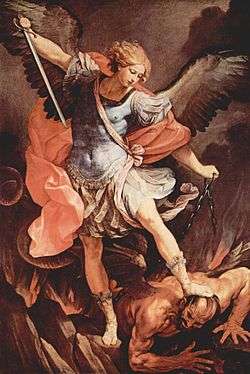Es erhub sich ein Streit, BWV 19
| Es erhub sich ein Streit | |
|---|---|
| BWV 19 | |
| Church cantata by J. S. Bach | |
 | |
| Occasion | Feast of Saint Michael |
| Performed | 29 September 1726: Leipzig |
| Movements | 7 |
| Cantata text | Picander |
| Chorale | by Christoph Demantius |
| Vocal |
|
| Instrumental |
|
Es erhub sich ein Streit (There arose a war), BWV 19,[lower-alpha 1] is a church cantata by Johann Sebastian Bach. He composed it in Leipzig in 1726 for the Feast of Saint Michael and first performed it on 29 September 1726.
History and words
The prescribed readings for the Sunday were from the Book of Revelation, Michael fighting the dragon (Revelation 12:7–12), and from the Gospel of Matthew, heaven belongs to the children, the angels see the face of God (Matthew 18:1–11).[1] The text of the cantata was written by Christian Friedrich Henrici, better known as Picander,[2] who includes as the closing chorale a stanza from a hymn by Christoph Demantius.
The chorale theme is Freu dich sehr, o meine Seele, which was codified by Louis Bourgeois when setting the Geneva Psalm 42 in his collection of Pseaumes octante trios de David (Geneva, 1551). Bourgeois seems to have been influenced by the secular song "Ne l'oseray je dire" contained in the Manuscrit de Bayeux published around 1510.
Scoring and structure
The piece is scored for three vocal soloists (soprano, tenor, and bass) and four-part choir, three trombe, timpani, two oboes, oboe da caccia, two oboes d'amore, two violins, viola, and basso continuo. Traditionally in Leipzig during Bach's time the Feast of St Michael celebrations used the largest orchestra available. All known complete Bach cantatas for this occasion include trumpet and timpani.[3]
It is in seven movements:
- Chorus: Es erhub sich ein Streit
- Recitative (bass): Gottlob! der Drache liegt
- Aria (soprano): Gott schickt uns Mahanaim zu
- Recitative (tenor): Was ist der schnöde Mensch, das Erdenkind?
- Aria (tenor) & Chorale: Bleibt, ihr Engel, bleibt bei mir!
- Recitative (soprano): Laßt uns das Angesicht
- Chorale: Laß dein' Engel mit mir fahren
Music
As with other Bach cantatas written for the Feast of St. Michael, this work opens with an "imposing" chorus. The opening and closing section of this da capo movement focuses on a single line of text describing the battle against the forces of evil. The middle section sets the remaining five lines of the text. The movement includes no instrumental introduction, creating an "immediate dramatic effect".[4] Craig Smith suggests that the "vaulting high-energy fugue theme is the perfect illustration of the heroic struggle".[3]
The bass recitative in E minor describes the importance of the victory over Satan, but exudes a sombre mood, suggesting the continued difficulties of mankind.[4]
The third movement is a soprano aria with obbligato oboes, "an oasis of protective tranquillity" in the major mode. However, elements of the music disturb the peace conveyed by the text: the extended ritornello begins with an "odd three-bar phrasing", leading into a passage of constant momentum between the two oboes.[4]
The tenor recitative is again in the minor mode, this time to describe the fragility of man. This movement moves into a striking tenor aria, describing a personal response to the text. The aria is the longest movement of the cantata, representing a third of the total length of the work.[4] The trumpet plays the full chorale melody of "Herzlich lieb hab ich dich, o Herr", probably with the third stanza mentioning angels in mind,[3] over a siciliano rhythm in the strings and continuo.[4]
The penultimate movement is a brief secco soprano recitative that returns to the major mode to prepare the closing chorale. The chorale has the feel of a minuet, although there is some tension because of the changing phrase lengths employed by the melody.[4]
Selected recordings
- Amsterdam Baroque Orchestra & Choir, Ton Koopman. J.S. Bach: Complete Cantatas Vol. 17. Antoine Marchand, 2003.
- Berliner Motettenchor / Berliner Philharmoniker, Fritz Lehmann. J.S. Bach: Cantatas BWV 1 & BWV 19. American Decca / Deutsche Grammophon, 1952.
- Gächinger Kantorei / Bach-Collegium Stuttgart, Helmuth Rilling. Die Bach Kantate Vol. 18. Hänssler, 1971.
- Heinrich-Schütz-Chor Heilbronn / Pforzheim Chamber Orchestra, Fritz Werner. Bach Cantatas: Volume 2. Erato, 1964.
- Holland Boys Choir / Netherlands Bach Collegium, Pieter Jan Leusink. Bach Edition Vol. 21 – Cantatas Vol. 12. Brilliant Classics, 2000.
- Monteverdi Choir / English Baroque Soloists, John Eliot Gardiner. Bach Cantatas Vol. 7: Ambronay/Bremen. Soli Deo Gloria 2000
- Stuttgart Choral Society / Bach-Orchester Stuttgart, Hans Grischkat. J.S. Bach: Cantatas BWV 6 & BWV 19. Renaissance, 1951.
Notes
- ↑ "BWV" is Bach-Werke-Verzeichnis, a thematic catalogue of Bach's works.
References
- ↑ "Lutheran Church Year - Readings for the Feast of St Michael and All Angels (September 29th)". bach-cantatas.com. Retrieved 21 December 2014.
- ↑ Sanford Terry, C.; Litti, D. (1917). "Bach's Cantata Libretti". Proceedings of the Royal Musical Association. 44 (1): 71–125. doi:10.1093/jrma/44.1.71. ISSN 0958-8442.
- 1 2 3 "Emmanuel Music - Bach Cantata BWV 19 - Program Notes". emmanuelmusic.org. Retrieved 21 December 2014.
- 1 2 3 4 5 6 Mincham, Julian. "The Cantatas of Johann Sebastian Bach - Chapter 25 BWV 19". jsbachcantatas.com. Retrieved 21 December 2014.
Sources
- Es erhub sich ein Streit, BWV 19: Scores at the International Music Score Library Project
- Cantata BWV 19 Es erhub sich ein Streit: history, scoring, sources for text and music, translations to various languages, discography, discussion, Bach Cantatas Website
- BWV 19 – "Es erhub sich ein Streit": English translation, discussion, Emmanuel Music
- Es erhub sich ein Streit: history, scoring, Bach website (German)
- BWV 19 Es erhub sich ein Streit: English translation, University of Vermont
- BWV 19 Es erhub sich ein Streit: text, scoring, University of Alberta